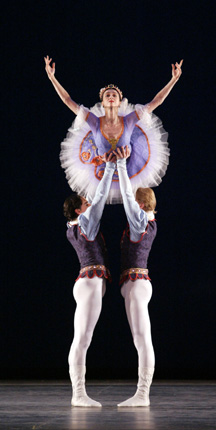ABT's Season Opens With a Sizzling Gala
Opening
Night Gala
American Ballet Theatre
Metropolitan Opera House
New York, NY
May 10, 2004
by
Susan Reiter
copyright
© 2004 by Susan Reiter
published 11 May 2004

They were treated to substantial excerpts from two of the season's major attractions: the new production of Raymonda and the revival of Ballet Imperial, as well as two pieces d'occasion: an affectionate salute to soon-to-be-90-year-old Frederic Franklin, and Kirk Peterson's spiffy Carmen Fantasy, with special guest violinist Sarah Chang brilliantly leading the way in the showy Sarasate score.
On the applause meter, the hands-down winner came early in the evening: the amorous first act duet from Kenneth MacMillan's Manon—by now a staple of ABT galas. Alessandra Ferri and Julio Bocca made it clear why: totally enraptured by each other, making every swooping lift an expression of sensual abandon, these two veteran Macmillan interpreters rode the impetuous arc of the Massenet music to an exhilarating final clinch. A close second, in terms of the volume of the audience's roaring approval, was Jose Manuel Carreno's bravura solo from the Diana and Acteon pas de deux, a late addition to the program. This is the kind of thing Carreno does do well—exuding masculine power but somehow not making the beefcake aspect look silly—and it's what audiences love to see him do, so adding this roughly one minute to the program was certainly justified.
Among the novelties, Balanchine's Tarantella (in an uncredited staging) was a welcome treat. Gillian Murphy and Ethan Stiefel, tall and golden, were interestingly cast against traditional type for this ballet, but as expert Balanchineans quickly made it their own. The piece became less feisty and more a sunny celebration. Murphy's skillfully applied her amazing clarity and expansiveness to the brisk witty footwork, and her always amazingly smooth and musically refined turning ability came in very handy here. Stiefel downplayed his innate elegance to put on a more rough and eager manner, but mainly impressed with the scale and vigor of his dancing. Tarantella here became less of a character piece and more of a simply joyful, vibrant give-and-take.

Parsons once found inspiration for a funny, gimmicky dance (The Envelope) in Rossini overtures, as this program included another choreographer's get-'em-laughing effort set to a Rossini overture: La Grand pas de Deux by Christian Spuck. As performed with perfect self-mocking flair by Irina Dvorovenko and Maxim Belotserkovsky, it made audiences cheer at City Center last fall, and the Russian duo's adept timing and self-mocking yet stylish performing made the work no less effective in the vastness of the Met. The bespectacled Dvorovenko's shenanigans with a pink purse quickly become tiresome and irrelevant, and I leave for someone else to ponder the significance of the cow sculpture placed upstage, but the work is brief and sassy enough to just avoid becoming tiresome.
Frederic Franklin's staging of Coppelia returns to ABT's repertory this season, and artistic director Kevin McKenzie put together a gloss on that work in A Sweet for Freddie, in which matched Swanildas (Amanda McKerrow and Ashley Tuttle) performed side-by-side solos before the divinely elegant Franklin himself strolled on to observe, and occasionally offer an arm in support, to a total of four Swanildas and their deferential Franzes. From time to time one of the women would freeze into a pose like the Coppelia doll, and one of the men would gesture to Franklin, who would undo the momentary spell with a wave of his arm. At the end, having unfrozen all four woman one more time, he happily strolled off surrounded by Swanildas, as the guys good-naturedly dealt with the abandonment.
Peterson's Carmen Fantasy was ideal gala fare—brisk, scintillating, and different from anything else on the program. It was also a showcase for a guest artist worthy of the name: violinist Sarah Chang, resplendent in a sexy Carmen-red gown and playing her violin with a blazing abandon appropriate to the opera's eponymous heroine. The work opened with an unusually sensual-looking Xiomara Reyes, sultry in a sleek red sheath, puffing the obligatory cigarette, which was soon tossed aside by her smoldering partner, Carlos Molina. Their taut, confrontational yet playful duet subtly evoked the impassioned face-off of the Carmen-Don Jose relationship while avoiding Spanish clichés. A new section of the music introduced two knowing, sleek passers-by, Misty Copeland and Adrienne Schulte, before Erica Cornejo and Herman Cornejo appeared for some rapid, smooth partnering. Peterson capitalized on their strong, sharp technique but gave the proceedings a contemporary edge. Things really started to sizzle as the pace quickened and the two women and the Cornejos traded off, flying across the stage in some amazingly sharp, fleet passages, carried along by Chang's virtuosic violin.

Two very contrasting ballerinas took on the lead roles: Paloma Herrera was cautious and reined-in during the challenging entrance solo, in which the ballerina has a chance to seize the stage and announce her presence. But she danced with more freedom and lucidity during the extended duet sequence, in which Gennadi Saveliev made a strong impression with some refined airborne passages. Michele Wiles, as the second ballerina, was expansive and clear, relishing the swift, crisp demands of the choreography. She claims the stage proudly yet modestly, while Hererra rarely radiates a presence that fills the space around her.

Photos:
First: Nina Ananiashvili and Marcelo Gomes in Raymonda. Photo: Rosalie
O'Connor.
Second: Angel Corella in Caught. Photo by Rosalie O'Connor.
Third: Scene from La Bayadere, Act II. Photo: Rosalie O’Connor
Fourth: Nina Ananiashvili in Raymonda. Photo: Rosalie O'Connor.
Originally
published:
www.danceviewtimes.com
Volume 2, Number 17
May 11, 2004
Copyright
©2004 by Susan Reiter
|
|